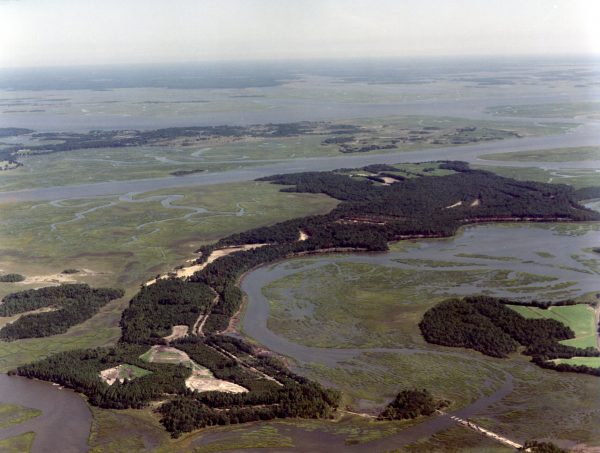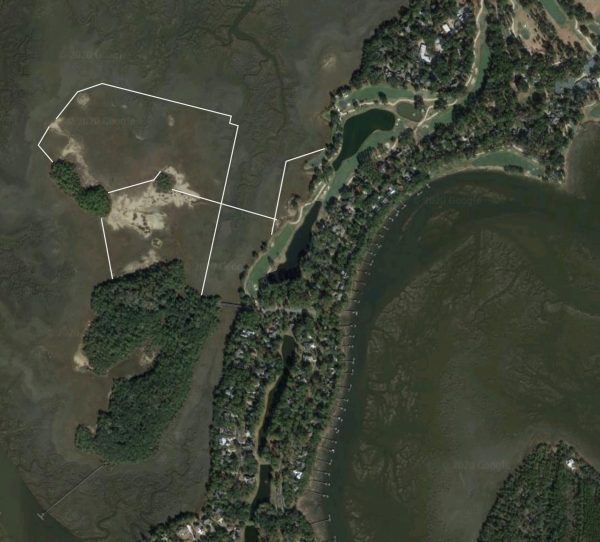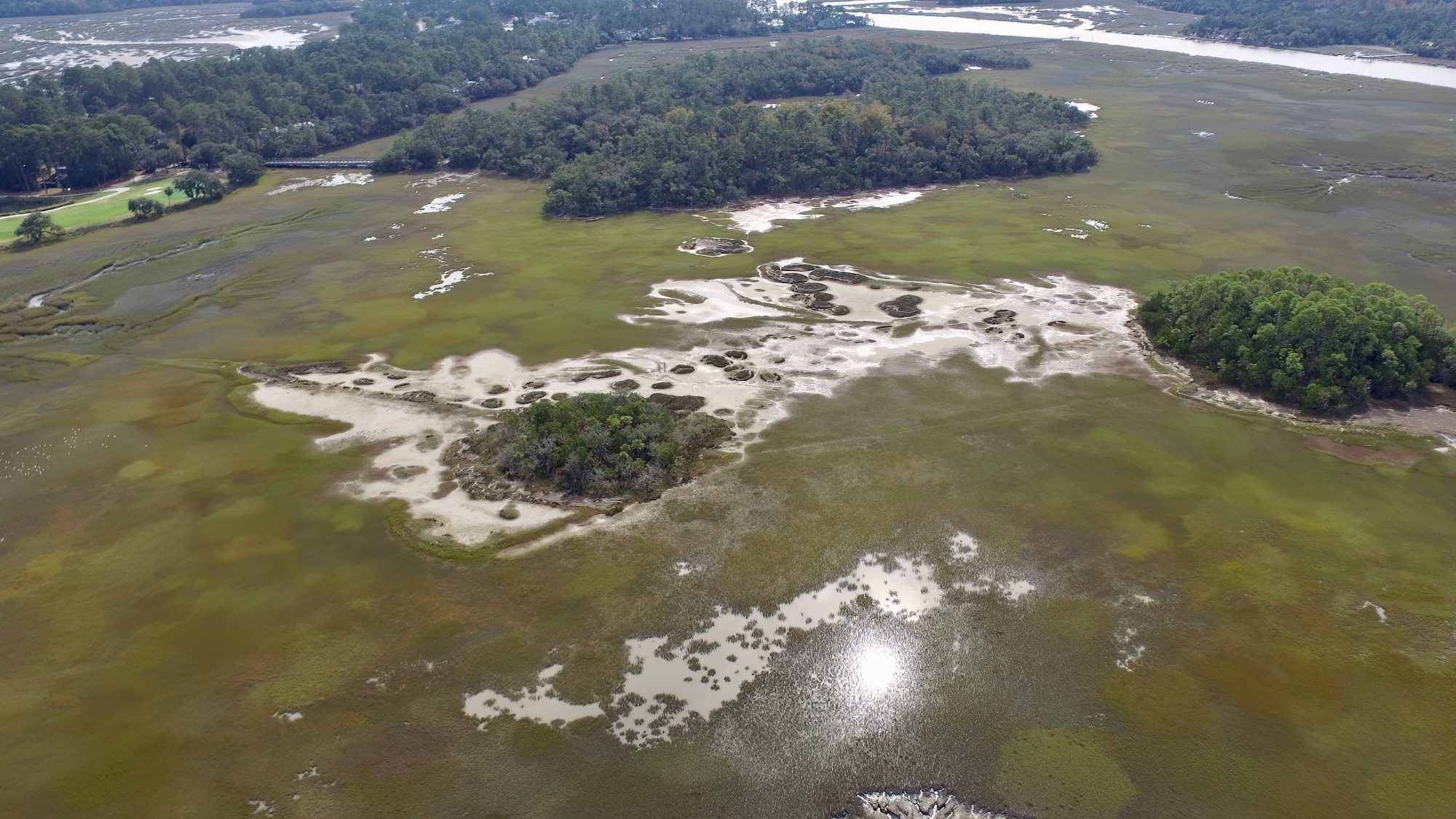Oak Island Adds to Both our Natural Beautify and our Historical Charm
Oak Island is a 32-acre natural beauty sitting next door to Dataw Island. (The picture above is from 1968.) Native Americans frequented the island about 1,000 years ago. Fast forward 800 years to the BB Sams / LR Sams plantation era, and it was an adventure spot for James Julius Sams and his brothers Horace and Donald. As Sea Island cotton took off as the “finest in the world,” BB Sams decided to build a system of dikes between Dataw Island, Oak Island, and the two marsh hummocks to the north (i.e., Pine Islands). According to JJ Sams, these dikes were designed to exclude water and reclaim cotton cultivation land; it didn’t work. They did not know then, but recent research by Colin Brooker reveals the issue was a lack of nutrients in the marshy soil, particularly potash. The elder Sams eventually converted the dams into a water retention system and created a series of ponds to attract migratory birds for hunting, with a more successful outcome. But this is only part of the story.
Mr. Brooker’s recent research, funded by the Dataw Historic Foundation, reveals a less BB Sams-centric origin for all the man-made features in this high marsh area. We now believe some of the features predated BB Sams time and were built to support inland rice cultivation up against the west side of Datha Island. This conclusion is supported by the design of the earthworks and their geometry with respect to a freshwater source, Sparrow Nest Creek.
After the Civil War, Oak Island, along with Datha Island, moved through many owners. Fortunately, none disturbed the island, save for one ‘historic’ use during prohibition! I’ll fill in the gaps in a minute, but recently a very generous (and anonymous) group of benefactors moved to bring Oak Island back into our community. Reverend James Julius Sams would be happy to hear this. Here are some of his reflections later in life about Oak Island, from his perspective as a kid exploring Oak Island in the 1840s.
…go and stand between Oak Island and the larger Pine Island, and the scene would amply repay every moment you spent gazing upon it. At any rate it always seemed to us, Horace and myself, and sometimes Donald, would take one of these positions and drink in the beauty of the picture, a picture wanting not one touch to make it perfect…
This is an excerpt from a much longer memoir written by the Reverend James Julius Sams (1826 – 1918) later in life; I believe around 1905. JJ is referring to his younger brother, Major Horace Hann Sams (1829 – 1865). James and Horace were only three years different in age and constant companions. In nearly every story in his full memoir, James mentions Horace. His description of their adventures on Oak Island clearly brought a smile to his writing. However, James Julius and his Sams’ brothers were not the first to gaze upon this site. We have evidence of people being on Oak Island 800 years earlier!
Native Americans
Oak Island is located in the high marsh west of lower Dataw. Off its northern shore are two hummocks, the Pine Islands referred to by James Julius Sams. It is made up nearly entirely of Williman soil (I.e., loamy marine sediment. I threw that technical term in for the Conservancy crowd out there.) The island has six historical sites surveyed by professional archaeologists back in the 1982 – 1988 timeframe. Evidence revealed that Native Americans frequented the island in the Late Woodland period (1000 – 1200 A.D.) They found shell midden piles and pottery shards on Oak Island, as well as extensive evidence of Native American presence next door on Dataw Island. The central part of Dataw Island is dominated by a broad southwest to northeast oriented ridge. This high and well-drained ridge is a prime location for settlement, and evidence for Native American transient occupation was confirmed. We have artifacts in the History & Learning Center, but no ‘ruins’ of these thousand-year-old settlements remain today. What they did find back in 1988 was substantial evidence of a “still operation” on Oak Island.
In addition to extensive physical evidence of a former still, the 1988 report says, “A local informant has stated that a still was operated here during the 1950’s, and that it was put out of business by government agents…”
The report concludes, the site is “…ineligible for the National Register. The site is a relatively common type in the region and has been purposely destroyed. The mechanics of this industry are fairly well understood and this site cannot contribute further significant information.”
Maybe we should settle for naming a drink in the Club House pub in honor of this historic site. How about “Oak Island Moonshine”! We’ve done something similar for another historical discovery on Oak Island. We named a golf course after the cotton dikes.

The Ponds
Here’s JJ Sams’ story about the cotton dikes. “Between Datha, Oak Island and the Pines were a number of ponds. These ponds were the result of an attempt made by my father [BB Sams] to obtain salt land for the planting of cotton. At one time there was a great rage among the Sea Island planters for salt lands. It had several advantages over other kinds of land. From the time the seed was up there was little or no trouble. The cotton grown on it required very little working, did not suffer much from either excess of rain or sun. After, however, the dams were built, my father found there was little or no soil, no soil near the surface or lower down. It was all sand. He tried the cotton. It came up badly and grew worse. It was a failure. My father, though, determined to put the work done and money spent to some use. Being quite a sportsman, and looking upon the wild duck as the very best of game for his family, always anxious for his children to have a variety of wholesome food, having a great many sons among his children, wishing to remove as far as possible the temptation to wander from home, he converted his experiment into a kind of game preserve. Hence these ponds that added so largely to the beauty of Datha, and contributed so much to the supplying of the table during the winter season.”
Today
As the sign on our golf course says, “This Dataw Island golf course, designed by Tom Fazio, is named for the earthen dikes or dams that were built here in the western marsh between 1850 and 1860 to increase the acreage for the valuable Sea Island cotton crop. …Unfortunately, soil conditions were not favorable, and the area was converted to duck ponds to attract migratory fowl.” From a broader perspective, the 1988 survey concluded these dikes were unique. They were massive in scope, encompassing about 60 acres of marsh, and have historical significance today. The 1988 report found, “It is the largest known example of 19th century Sea Island salt marsh land management practices. Its outline is relatively well preserved and stable, and it is a unique element of the 19th-century plantation system.”
You can still see remnants of the dikes today when looking from the southwestern shore of Dataw Island (i.e., from Cotton Dike #5 & #6), looking north from the Oak Island bridge, and soon (we hope) when standing on the northwestern shore of Oak Island. If you know what you’re looking for, you can even see most of their footprint on Google maps.

It seems appropriate to leave you with another JJ Sams recollection from his childhood on Dataw Island.
Often did we sit in the Piazza of the west house and enjoy the scene, listening at the same time to the Too whoo, Too whoo, whoo-whoo of the great white owl, which came from the woods of Oak Island.
Sources
Brooker, Colin and Morillo, Benjie – Drone Survey of Reclaimed Salt Marsh off Dataw and Oak Islands, Beaufort County, South Carolina, performed for Dataw Historic Foundation on November 21, 2022. Available here.
Riski, William A – Oak Island Chain of Ownership, 2020. Available here.
Sams, Rev. James Julius – Datha, circa 1905. Available here.


